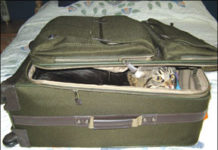Persistent Wool Sucking
Q: We have an 8-month-old male RagaMuffin kitten that suckles on either my skin or clothing. If I remove him, he suckles on blankets...
How Cats Land on Their Feet
Cats are well-known for their ability to land on their feet almost all the time. This talent has fascinated people for centuries, and as...
Cats Love Boxes and Perches
Can’t find your cat? Check all the little nooks and crannies in your house, from the U-bend under the sink to the top of...
Smaller Brain Size
A study published in the Royal Society Open Science found that domestic cats have smaller cranial volume, aka brain size, than their ancestors.
The researchers...
The Aging Cat Needs a Careful Eye
When we hear someone tell us our senior cat “looks really good for her age,” we might want to give some thought to that...
Download the Full August 2016 Issue PDF
If you actually catch the cat in the act of inappropriately urinating or defecating, you can say No! However, a cat may not use the box because he is not feeling well. Medical causes should always be explored. For example, a bladder infection could cause him to connect its pain with using the litter box. Arthritis may prevent easy entry to the box.
Cats’ Behavior Affected Crucially Early in Life
Most of us recognize obvious signs of stress and anxiety in our cats - taking up residence under the bed being high on the list - but we may not be aware of more subtle signs, such as lowering the head and eyes, lifting a paw and staring at middle distance. These are among nearly 40 behaviors that may require intervention, according to the American Animal Hospital Associations 2015 Canine and Feline Behavior Management Guidelines, published this past summer. Behavioral problems affect more dogs and cats than any other medical condition and are one of the most common causes of euthanasia, relinquishment or abandonment of pets, the association says, adding that their management is essential in veterinary practice. It urges a culture of kindness that avoids the use of forced restraint.
Cats and Kids: A Recipe for Success
Cats and kids: A match made in heaven? Perhaps. Some cats are shy or skittish, and prefer to retreat to a safe spot, watching noisy, busy children from a distance. Some cats would not hesitate to swat or bite in order to keep a child from coming too close. Yet, except when distracted by a sunbeam, or by some birds fluttering outside the window, most house cats stay close to the family circle. Social cats seek the laps of adults and children alike, enjoying a gentle stroke now and again. Indeed, petting a cat can be a calming experience. Still, many children want more from their companion. Sometimes, that translates into cats being dressed up in dolls clothing. Okay, there are worse experiences than walking around in a baby bonnet. But being dressed up would probably not qualify for environmental enrichment in the mind of a cat. Consider that it is possible to offer pleasure to kids and cats alike. After all, both kids and cats love to play. Yet playtime generally sends them in different directions. Why not invent some games that both can enjoy?
Hark, Who Goes There?
Quite often, I am told tales of apparently mild-mannered cats that seem to tolerate all of lifes challenges save one: the Trespasser. When face to face with a Cat Errant, Mr. Mellow just cannot cope. We are all cat lovers and certainly wish no harm to our neighbors cats. But naturally, we want to look out for our family. When a resident cat spies a potential intruder, several responses are possible. If you are lucky, your cat might believe that the more, the merrier. He may chirp, he may posture in a beckoning manner, or he may continue to nap calmly, with no apparent interest in the antics of his comrade through the glass. If you are less lucky, you may find that your cat does not trust that the glass is sufficient to keep an offending cat at bay. He may post "Private Property" signs of his own. You may come home to discover that your windows and doors have been marked with urine. If you manage to get through the winter months unscathed, beware the ides of April. For when the windows are opened for a little fresh air, the urgency to reset the barriers will return. The most concerning cat of all is the cat that experiences profound fear upon viewing an unfamiliar cat. The frightened cat may respond by redirecting aggression toward a member of your household. Although other cats are most frequently targeted, other pets and people may find themselves victims of serious attacks. The impact on a relationship can be devastating. Fortunately, you can intervene. You will need to work with both sides of the equation.
Who Are You, Anyway?
Lets be honest: Anyone can have a bad day. Maybe the car wouldnt start. Or you forgot to set the alarm and were late for an important meeting. You might have snapped at a loved one who asked a simple question. When bombarded with an unidentified scary sound, a cat may believe that she is under attack. Perhaps your painter needed to power-wash the deck. Maybe something triggered your neighbors alarm system. Nellie, a nervous kitty, could take refuge in the closet. Or, she may instead attempt to learn the source of the scare. She will take a mental snapshot of the scene. Anything in the picture becomes suspect. Her housemate, Sue, seems a likely culprit. Frightened cats are not reasonable, and fear is a powerful trigger for aggression. Without taking time to recall that Sue has always been a friendly companion, Nellie initiates an attack. Naturally, Sue will be caught off guard. She could fight back, or will probably head for cover. As your day improves, you will probably get back on track. The victim of your ill humor - understanding that your behavior was nothing personal - will still treat you kindly. If only our cats could be as understanding. Sadly, a hiss, growl or swat from a trusted feline companion may set off a cycle of aggressive behavior that can take weeks, months or even years to resolve. Sometimes, an inciting event can clearly be identified. Often, folks come home to find that their cats seem to be at war.
Home Sweet Home … For Your Cat
Sooner or later, most people find themselves moving to a new home. The experience can be daunting for all concerned. Amazingly enough, as long as they have their special people, most cats seem to adapt to new surroundings with no trouble at all. Still, a little prior planning can smooth the way. Lets examine some potential problem areas. It is of course both normal and desirable for a cat to explore a new environment. A bit of care must be taken so that one does not lose ones cat. Take time to block any openings that would allow a cat to reach areas that you yourself could not access should the need arise. Otherwise, you could find yourself cutting holes in sheetrock, disconnecting your home theatre or even removing plumbing fixtures to retrieve a frightened feline. In fact, if your new home is quite large, you might want to use gates or doors to initially limit the areas that your cat can access without supervision. Offer an assortment of cat-friendly mats and perches in these areas. As you offer access to more areas of the house, begin to move these familiar beds to the new locations. Do scan each new area for any toxic materials or other dangerous situations.
Cat Play: An Essential Part of Her Care
Play is an intriguing behavior. Scientists even speculate on its function. Since all species seem to engage in play on some level, it must fulfill an important need. It might prepare youngsters for future tasks such as hunting or fighting. It certainly serves to refine communication skills between participants, and it offers an opportunity for aerobic exercise. But the main reason we play is quite simply that playing is, by definition, fun. Play is a treat that we can and should offer to our cats. Naturally we cannot engage in precisely the same games that cats play with one another. What is the best way to provide play? The first step is to establish some ground rules. No one should get hurt or be frightened. If a cat hisses, bites, or runs away, then the game should be discontinued. Another important rule is that human body parts should not be used as substitutes for toys. That is to say, a cat should not be encouraged to grab or chase hands, fingers or legs. A pony tail is not a toy. The bottom line is that cats cannot help the fact that they are predators. The drive to hunt is a powerful one, and even the most sophisticated housecat can become a skilled huntress at the sight of a tiny mouse. It is not at all uncommon for cats to stalk hands or legs or to pounce forcefully onto a long braid. Even with absence of malice, harm can be done. An ounce of prevention will serve you well. Encourage your cat to play with appropriate toys.
















